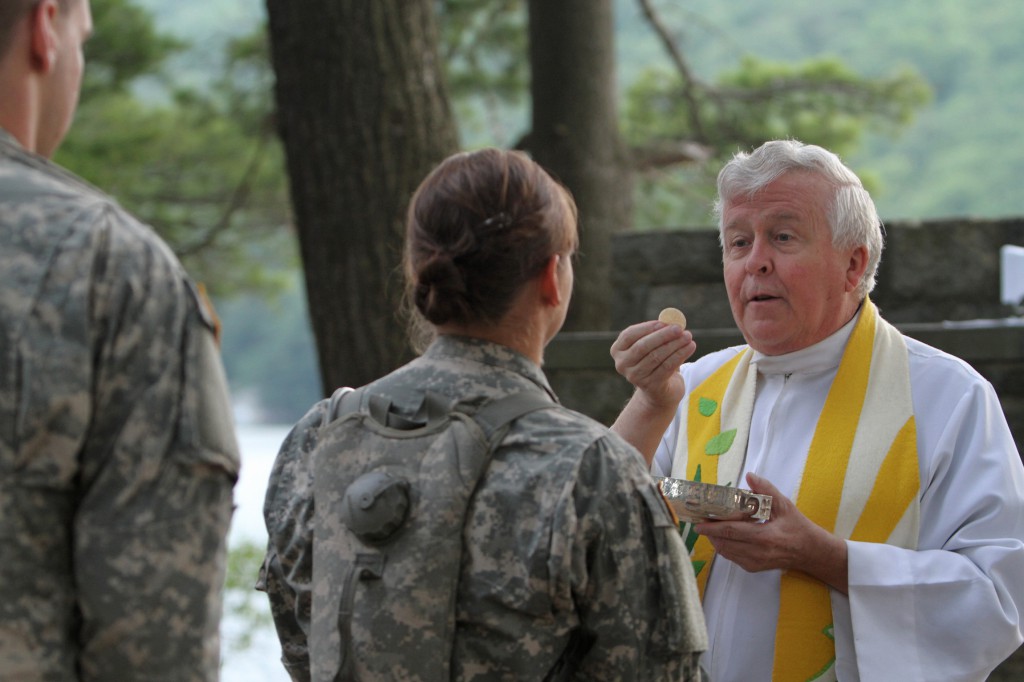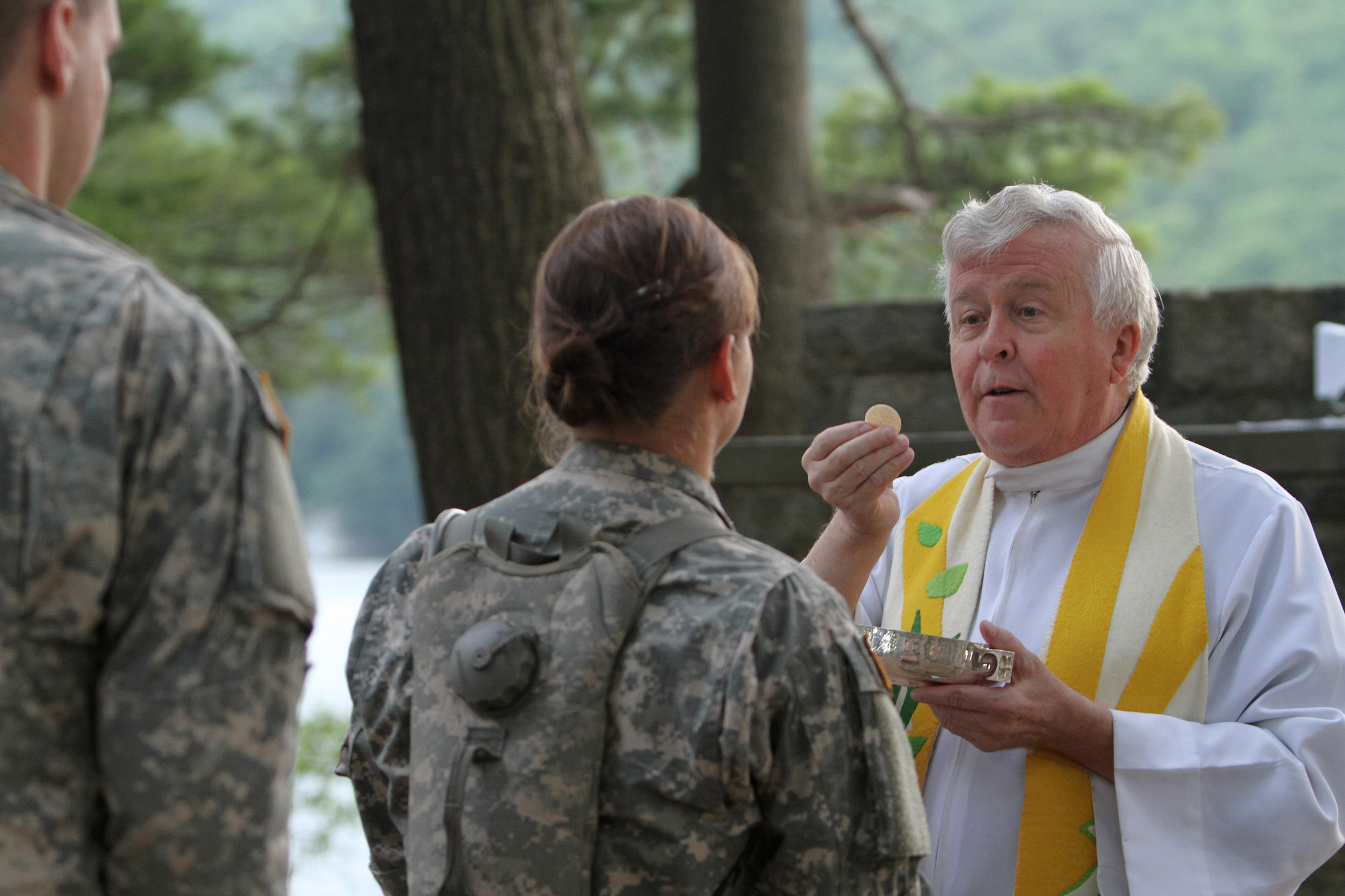
A local Valley man known as “JC” can still hear the Irish brogue of his Catholic chaplain in Vietnam. It was the priest who kept his spirits in check.
Another veteran, a newly promoted lieutenant junior grade in the U.S. Navy, is from the Diocese of Brooklyn. Mark Bristol became a sailor at 17 and began discerning the priesthood three years later.
[quote_box_right]
Archdiocese for the Military Services, USA
The archdiocese has no territorial borders. It serves military members and their families wherever they’re assigned and incurs considerable travel costs for clergy.
To learn more, call
(202) 719-3600 or visit:
[/quote_box_right]He’s now in his third year of theology through a co-sponsored seminarian program. He is on track to be ordained both a priest for his home diocese and a military chaplain through the Archdiocese for the Military Services, USA.
“Being a Catholic and seeing the lack of priests available, I saw a great need,” Bristol said.
The archdiocese, which is responsible for more than 1.8 million men, women and children — domestically and at 220 installations in 29 countries — knows there’s a great need too. The number of priests on active duty has fallen by 40 percent, down from more than 400 in 2001 to 234 today.
Archdiocesan leaders are grateful that more and more men are discerning a call to both the priesthood and the military chaplaincy. There are 37 seminarians in the archdiocese’s co-sponsored seminarian program — which shares the cost of a priestly formation with a seminarian’s home diocese — a 12-fold increase from its launch five years ago.
“The country has been at war for more than 10 years. The men and women in the military, and their families, have experienced a very heavy professional and personal burden and a number of hardships. They rely on our Catholic chaplains for spiritual guidance and support,” said Archbishop Timothy A. Broglio, who has led the archdiocese since 2007.
Some $2.7 million is needed to fund their formation in the next five years.
“Without priests, we don’t get the Eucharist. That’s what’s happening with our military throughout the world,” Bob Holsinger, a district master for the state’s Knights of Columbus, told The Catholic Sun after the Nov. 3 “Red, White and Blue” Mass honoring veterans and active duty military personnel.
Holsinger is among Arizona’s Fourth Degree Knights of Columbus praying for and supporting the military’s future priest chaplains. The Knights of Columbus Supreme Council pledged $1 million over five years for the vocations program.
Arizona councils have already surpassed their local goal raising some $23,000. Funds from a U.S. bishops-approved special collection held Nov. 9-10 at parishes nationwide will also support vocations, among other efforts.
“We’re every bit as short now in the military as in the diocesan [programs],” said Fr. John Kaul, interim director of vocations for the military archdiocese. “The chaplains we have are shipped right to the front.”
Catholic chaplains are in high demand. While roughly 25 percent of the military is Catholic, priests make up only about 8 percent of the chaplain corps. New vocations are not keeping up with priests reaching a mandated retirement age — eight years sooner than diocesan priests.
Fr. Matthew Pawlikowski from the Archdiocese of Newark became an Army chaplain in 2000 and was an unofficial chaplain for ROTC cadets and officers while in seminary.
“They put stresses on themselves and their families and make great sacrifices for our safety. That is a clientele that I think is an honor to serve. It’s an honor to be a priest for anyone, but especially to serve the military and their families,” Fr. Pawlikowski told priests at this year’s National Conference for Diocesan Vocation Directors.
Bristol, the third-year seminarian from Brooklyn, had a similar view. He sees being a priest chaplain for the military as a way of continuing a military career that he loves and bringing honor to his job, his family and his country.
It took Bristol two years to find a chaplain while in the Navy, but he knows the benefit of having a priest around.
“It brings up the morale of the crew,” Bristol said. The sailor found that a priest’s mere presence made missions easier to accomplish and brought a sense of peace. He also noted the role of the sacraments, particularly the Eucharist.
“Your day had some sort of connection to back home,” Bristol said.
Fr. Kaul agreed. He spent 26 years as a Navy chaplain.
“When they leave home and join the military, they’re taken out of every support system that they have,” Fr. Kaul said.
Faith is often their main source of security and hope. That’s what Fr. Pawlikowski, the Army chaplain, gently preaches when he encounters soldiers.
“Some of the guys will say, ‘Hey Chaplain, where’s your weapon?’ I tell them, ‘Right here,” Fr. Pawlikowski said, slapping his hands together in prayer with a rosary. ✴
Catholic News Service contributed to this story.






